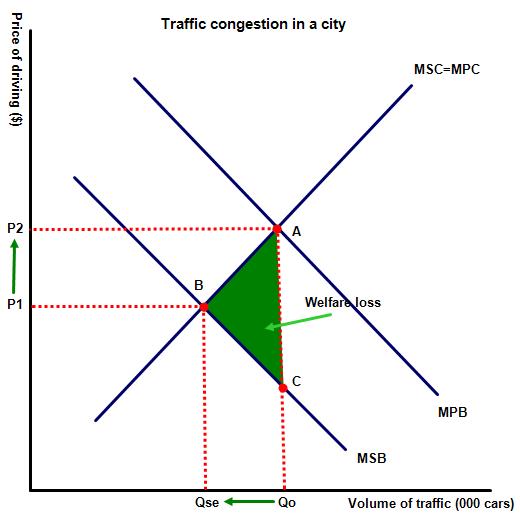Mark scheme Q7 microeconomics (unit 2.7)
 Teacher notes
Teacher notes
This paper 1 style question, on the impact of indirect taxes on consumption demerit goods, is in two parts. The first requires candidates to illustrate, using a diagram, how a tax on fuel can be used to reduce pollution levels in a city. Part (b) requires a far more evaluative response with students required to evaluate the effectiveness of such a policy.
7. (a) Explain with a diagram how the government imposition of a specific tax could reduce pollution levels in a city. [10 marks]
I n completing this question responses could include the following:
n completing this question responses could include the following:
Key terms to define: demerit goods, externalities and specific sales taxes.
Examples of relevant taxes that might be used to reduce the volume of cars in a city e.g. a specific tax on petrol, a tax on new car ownership or an electronic road pricing system similar to the one used in cities around the world such as London or Singapore.
A diagram illustrating that in unregulated markets the number of car journeys in the city (output Q0) will exceed the socially optimum level, represented by Qse. This is because the equilibrium price (P1) is derived from the private costs and benefits only (MPC = MPB) and does not consider the social benefits of consumption (MSB), which are lower than the MPB enjoyed by the car owner. The social costs of  excessive car journeys in the city include greater levels of pollution, lost productivity due to increased journey times and a greater number of accidents on the road. In other words the price of using a car in the city (P1) is too low from the view point of the cities residents.
excessive car journeys in the city include greater levels of pollution, lost productivity due to increased journey times and a greater number of accidents on the road. In other words the price of using a car in the city (P1) is too low from the view point of the cities residents.
A recognition that by imposing a specific sales tax equal to the size of the externality then the government can correct this market failure and reduce the size of the inefficiency in the market.
Examples of some alternative solutions for reducing pollution such as legislation, greater subsidies on public transport, specific lanes for public transport e.t.c, which work by reducing demand for car journeys rather than raising the cost of driving. This would be represented on a diagram by a left shift in demand so that demand is now closer to the MSB of driving.
Responses for section (a) should be graded according to the following mark bands:
Maximum mark for this section 10.
Criteria | Mark |
There is no clear answer to the question but some limited:
| 1-2 |
There is a vague answer to the question with limited:
| 3-4 |
There is an answer to the question with satisfactory:
| 5-6 |
There is a clear answer to the question with good:
| 7-8 |
There is clear answer to the question with excellent:
| 9-10 |
(b) Evaluate the effectiveness of indirect taxes in reducing the consumption levels of demerit goods such as tobacco, petrol and alcohol products? [15 marks]
In this example the command term requires candidates to evaluate not only how the government can use taxes to reduce consumption of demerit goods, but also consider the merits and costs of the policy.
In completing this question responses should include some of the following:
Key terms to define: demerit goods, externalities and specific sales taxes.
A definition of demerit goods, externalities and indirect taxes. Candidates should already have defined both terms in part (a) of the question so they do not need to repeat those definitions, but should refer to those definitions in the beginning part of the response.
 Examples of the negative externalities caused by the consumption of fuel, tobacco and alcohol products. These will include the economic and social costs of consumption.
Examples of the negative externalities caused by the consumption of fuel, tobacco and alcohol products. These will include the economic and social costs of consumption.
A diagram providing an explanation of why in unregulated markets demerit goods such as tobacco, petrol and alcohol products tend to be over consumed due to being sold below the socially optimum price. This is illustrated on diagram 1, where Q2 represents the socially optimum level of output for a demerit good and Q1 represents the level of output in an unregulated market. This is caused by a market price of $50, which reflects only the MPC of consumption, represented by S1, rather than a market price of $70, which reflects the MPC and MSC or production.
Responses should then continue by stating that with the imposition of a specific sales tax, equal to the size of the externality, the government can correct the market failure and reduce the size of the inefficiency in the market. Following the sales tax, price will rise from $50 to $70 and quantity demanded will fall from Q1 to the socially optimum level of Q2.
On the other hand, there are also disadvantages of imposing a specific tax on demerit goods. Examples include:
As a result of the sales tax the real income levels of consumers may fall, ma ny of who may be from low income households.
ny of who may be from low income households.
That given the addictive nature of petrol, alcohol and tobacco products, for example, the impact on consumption may be relatively small. Such goods typically have low levels of PED elasticity, which means that a tax on those products may be largely ineffective in reducing consumption, illustrated on diagram 2 by the green shaded area, but will raise a significant amount of tax revenue, illustrated by the orange area - leading to questions over the real motivations of governments imposing a tax.
A recognition that as a result of the tax and the addictive nature of those products, many low income households may react to the tax by cutting back on other essential items such as food rather than reduce their consumption of alcohol and tobacco products.
A recognition that a rise in the selling price due to an increase in indirect taxation is also likely to lead to a rise in smuggling and black market sales.
A recognition of alternative policies that a government may employ to reduce consumption of a demerit good. Examples include marketing campaigns promoting anti smoking, legislation or investment in alternatives such as offering counselling courses, hypnotherapy to help smokers quit the habit or improvements to public transport. Candidates would be rewarded for including examples from their own nations, such as how a long term campaign of specific taxes on tobacco products has reduced consumption rates in many parts of the world.
Responses should finish with a conclusion considering the strengths of both arguments, as well as the impact on different stakeholders (e.g. consumers and tax payers) and the short and long term consequences of a sales tax. An example might be that in the short-term a sales tax will have little impact on consumption levels but may reduce sales levels over time, as many nations have done successfully with cigarette consumption.
Responses for section (b) should be graded according to the following mark bands:
Maximum mark 15
Criteria | Mark |
There is no clear answer to the question but some limited:
| 1-3 |
There is a limited answer to the question with limited:
| 4-6 |
There is a satisfactory answer to the question with satisfactory:
| 7-9 |
There is a good answer to the question with good:
| 10-12 |
There is an excellent answer to the question with excellent:
| 13-15 |
Available as a PDF at: Mark scheme Q7
